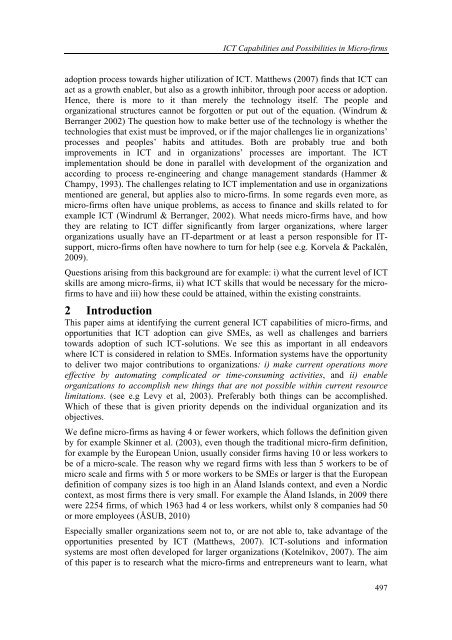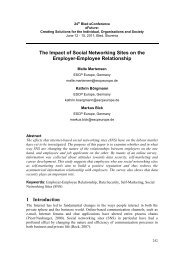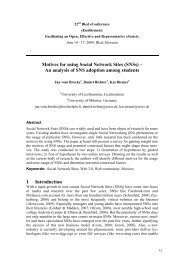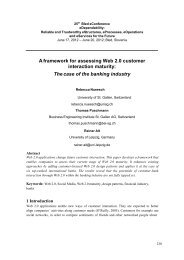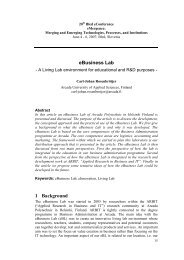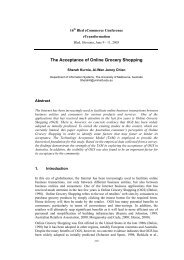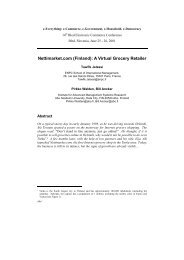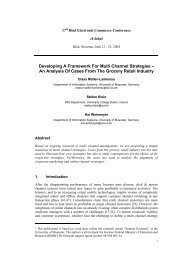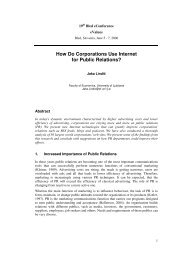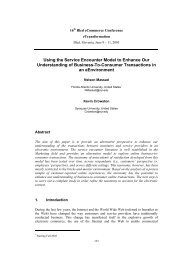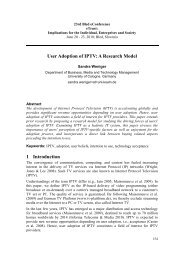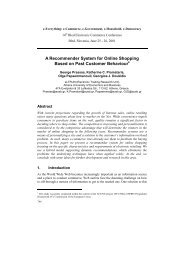ICT Capabilities and Possibilities in Micro-firms: 1 Background
ICT Capabilities and Possibilities in Micro-firms: 1 Background
ICT Capabilities and Possibilities in Micro-firms: 1 Background
Create successful ePaper yourself
Turn your PDF publications into a flip-book with our unique Google optimized e-Paper software.
<strong>ICT</strong> <strong>Capabilities</strong> <strong>and</strong> <strong>Possibilities</strong> <strong>in</strong> <strong>Micro</strong>-<strong>firms</strong><br />
adoption process towards higher utilization of <strong>ICT</strong>. Matthews (2007) f<strong>in</strong>ds that <strong>ICT</strong> can<br />
act as a growth enabler, but also as a growth <strong>in</strong>hibitor, through poor access or adoption.<br />
Hence, there is more to it than merely the technology itself. The people <strong>and</strong><br />
organizational structures cannot be forgotten or put out of the equation. (W<strong>in</strong>drum &<br />
Berranger 2002) The question how to make better use of the technology is whether the<br />
technologies that exist must be improved, or if the major challenges lie <strong>in</strong> organizations’<br />
processes <strong>and</strong> peoples’ habits <strong>and</strong> attitudes. Both are probably true <strong>and</strong> both<br />
improvements <strong>in</strong> <strong>ICT</strong> <strong>and</strong> <strong>in</strong> organizations’ processes are important. The <strong>ICT</strong><br />
implementation should be done <strong>in</strong> parallel with development of the organization <strong>and</strong><br />
accord<strong>in</strong>g to process re-eng<strong>in</strong>eer<strong>in</strong>g <strong>and</strong> change management st<strong>and</strong>ards (Hammer &<br />
Champy, 1993). The challenges relat<strong>in</strong>g to <strong>ICT</strong> implementation <strong>and</strong> use <strong>in</strong> organizations<br />
mentioned are general, but applies also to micro-<strong>firms</strong>. In some regards even more, as<br />
micro-<strong>firms</strong> often have unique problems, as access to f<strong>in</strong>ance <strong>and</strong> skills related to for<br />
example <strong>ICT</strong> (W<strong>in</strong>druml & Berranger, 2002). What needs micro-<strong>firms</strong> have, <strong>and</strong> how<br />
they are relat<strong>in</strong>g to <strong>ICT</strong> differ significantly from larger organizations, where larger<br />
organizations usually have an IT-department or at least a person responsible for ITsupport,<br />
micro-<strong>firms</strong> often have nowhere to turn for help (see e.g. Korvela & Packalén,<br />
2009).<br />
Questions aris<strong>in</strong>g from this background are for example: i) what the current level of <strong>ICT</strong><br />
skills are among micro-<strong>firms</strong>, ii) what <strong>ICT</strong> skills that would be necessary for the micro<strong>firms</strong><br />
to have <strong>and</strong> iii) how these could be atta<strong>in</strong>ed, with<strong>in</strong> the exist<strong>in</strong>g constra<strong>in</strong>ts.<br />
2 Introduction<br />
This paper aims at identify<strong>in</strong>g the current general <strong>ICT</strong> capabilities of micro-<strong>firms</strong>, <strong>and</strong><br />
opportunities that <strong>ICT</strong> adoption can give SMEs, as well as challenges <strong>and</strong> barriers<br />
towards adoption of such <strong>ICT</strong>-solutions. We see this as important <strong>in</strong> all endeavors<br />
where <strong>ICT</strong> is considered <strong>in</strong> relation to SMEs. Information systems have the opportunity<br />
to deliver two major contributions to organizations: i) make current operations more<br />
effective by automat<strong>in</strong>g complicated or time-consum<strong>in</strong>g activities, <strong>and</strong> ii) enable<br />
organizations to accomplish new th<strong>in</strong>gs that are not possible with<strong>in</strong> current resource<br />
limitations. (see e.g Levy et al, 2003). Preferably both th<strong>in</strong>gs can be accomplished.<br />
Which of these that is given priority depends on the <strong>in</strong>dividual organization <strong>and</strong> its<br />
objectives.<br />
We def<strong>in</strong>e micro-<strong>firms</strong> as hav<strong>in</strong>g 4 or fewer workers, which follows the def<strong>in</strong>ition given<br />
by for example Sk<strong>in</strong>ner et al. (2003), even though the traditional micro-firm def<strong>in</strong>ition,<br />
for example by the European Union, usually consider <strong>firms</strong> hav<strong>in</strong>g 10 or less workers to<br />
be of a micro-scale. The reason why we regard <strong>firms</strong> with less than 5 workers to be of<br />
micro scale <strong>and</strong> <strong>firms</strong> with 5 or more workers to be SMEs or larger is that the European<br />
def<strong>in</strong>ition of company sizes is too high <strong>in</strong> an Ål<strong>and</strong> Isl<strong>and</strong>s context, <strong>and</strong> even a Nordic<br />
context, as most <strong>firms</strong> there is very small. For example the Ål<strong>and</strong> Isl<strong>and</strong>s, <strong>in</strong> 2009 there<br />
were 2254 <strong>firms</strong>, of which 1963 had 4 or less workers, whilst only 8 companies had 50<br />
or more employees (ÅSUB, 2010)<br />
Especially smaller organizations seem not to, or are not able to, take advantage of the<br />
opportunities presented by <strong>ICT</strong> (Matthews, 2007). <strong>ICT</strong>-solutions <strong>and</strong> <strong>in</strong>formation<br />
systems are most often developed for larger organizations (Kotelnikov, 2007). The aim<br />
of this paper is to research what the micro-<strong>firms</strong> <strong>and</strong> entrepreneurs want to learn, what<br />
497


